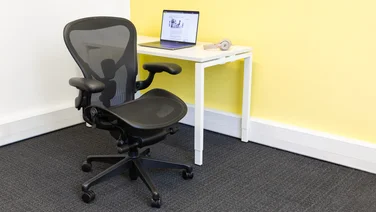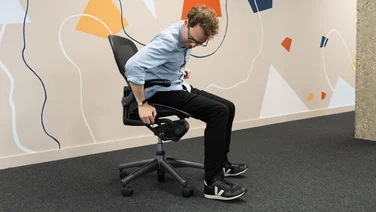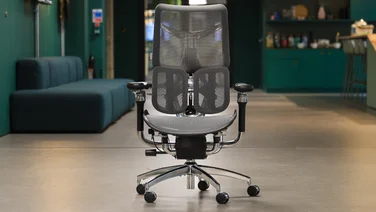To help us provide you with free impartial advice, we may earn a commission if you buy through links on our site. Learn more

Most of the best office chairs have a bevy of adjustable levers and knobs that can be operated when seated. While their use is designed to be intuitive, getting precisely the right adjustment can be slightly confusing at first.
What are the most common adjustable features?
Seat height – Powered by a pneumatic cylinder, a lever allows the chair to smoothly move up and down a range of heights. It’s usually under the seat on either the left or right side.
Seat tilt – A lever allows the seat and backrest to tilt simultaneously (also called “tilt-in-space”). It’s sometimes adjusted via a handle that requires a “flip” motion in order to operate.
Tilt tension – You might see a separate “tilt tension adjustment” function, which adjusts the amount of force needed to tilt the chair to a preferred reclining angle. It’s typically a turnable knob under the front of the seat.
Tilt lock – Also called “tilt recline lock”, this allows for locking both the backrest and the seat in your preferred position, be it upright or reclining at various degrees. The location of the tilt lock lever varies between chair models.
Backrest angle/recline – Being able to recline the backrest’s angle relative to the seat lets you lean back while working or helps you maintain a straight back.
Lumbar support – Placed at your lower back, the cushion-like lumbar portion of the chair supports the natural curvature of the spine. Ideally, the lumbar support will be independently adjustable from the backrest.
Armrest height and width – While not always useful for desk working, adjustable armrests can help to support your forearms and alleviate wrist tension. They’re usually adjusted via a small tab or button on the armrest itself.
READ NEXT: Best office chairs for back pain
Other adjustable features
You might also find these adjustments available on an office chair:
Seat pan depth – This allows you to adjust the depth of the seat by moving either the seat or the backrest forward and back, closing the gap between both these parts of the chair.
Backrest height – A higher backrest helps with supporting the upper back, shoulders and neck.
Position of lumbar support – Adjusting the position of the lumbar support can provide extra support for the lower back. Depending on your chair, you may also be able to adjust the depth (and even the firmness) of the lumbar support area.
Check that your desk is at the correct height
The standard desk height in the UK is between 70 and 74cm, allowing for the general population to be between 5ft 8in and 5ft 10in tall. That said, the ideal height for your desk is ultimately influenced by your seated height: your computer screen should be at eye level, with no craning or bending of your neck.

Your legs should also fit comfortably beneath the desk: if there’s not enough space then your desk is too low.
READ NEXT: Best ergonomic office chairs
Find the correct sitting posture
To get a chair’s adjustments correct, you need to get your seated position right. Good posture is key to avoid slouching and leaning – otherwise you’ll still exert strain on various parts of your body despite using a pricey chair.
The best desk position requires the following:
Feet resting flat on the floor
Ankles in front of your knees (no crossing your legs if you can help it)
Thighs horizontal and roughly parallel with the floor
If there are armrests, your arms should be resting on them gently
Elbows close to the body and bent at a right angle
Forearms in line with the desk
Neutral wrists
Upper arms as close to your torso as possible
Relaxed shoulders
Adjust the seat height and depth
To raise the seat height, find the lever beneath the seat. While maintaining a straight back and your feet flat on the floor, pull up on the lever while raising your body slightly off the seat. Pressing down on the lever while sitting will make the height decrease. Experiment with raising and lowering the chair’s height until your knees sit below your hips.

You can also adjust the depth of the seat pan, which changes the amount of space between the front edge of the seat and the backs of your knees. A general rule of thumb is about three fingers-width: less than this and your knees will be uncomfortable.
READ NEXT: How to stop an office chair squeaking
Adjust the backrest’s angle and height
A slight recline in your chair usually creates the most comfortable position for the natural curve in your spine, meaning a backwards tilt of around 100-degrees. That said, when working at a desk or keyboard you’re likely to lean forward a little – so unless you’re a habitual recliner, locking your chair at a slight forward tilt is also beneficial.

It’s easiest to lower the backrest when you’re sitting, so start by raising it to its maximum height before sitting down. Then adjust the position of the backrest until it’s a comfortable fit with the small of your back.
Adjust the armrests
If you use a chair with armrests, they should be adjusted to a height that barely touches the underside of your forearm when your elbows are bent at a right angle.
Once you’re sitting on the chair, the armrests should be as close to you as possible. This in turn keeps your elbows close to your body for maximum comfort.





